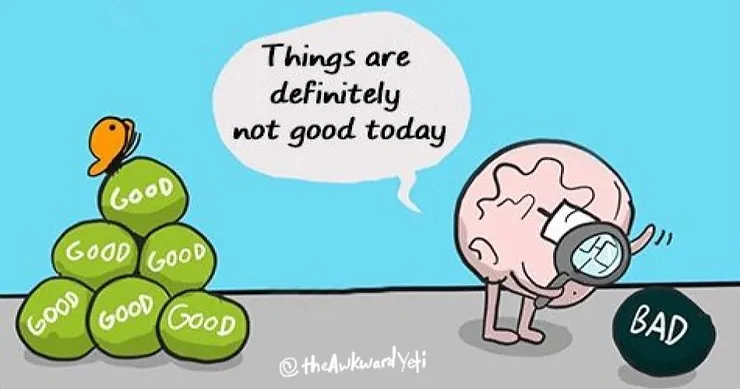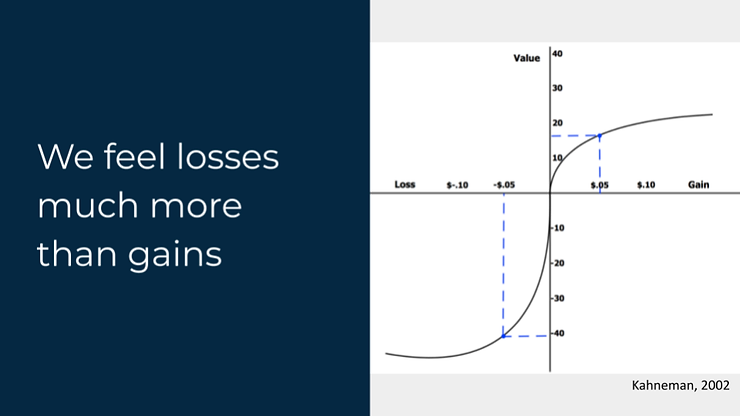16th February, 2021 • 4 min

Written by Augusta Vivian
3rd April, 2023 •

Have you ever found yourself replaying a negative memory over and over again? Or dwelling on the negative comment someone made last week? You are not alone. Most of us find ourselves thinking about negative things more frequently than the positive things due to the negativity bias.
So, what is the negativity bias?
The negativity bias is a cognitive bias that means we focus more on the negative than the positive. We are biased towards negative stimuli, events and memories. We feel these negative events more intensely than we feel positive events like someone sharing praise with us, a happy moment in your week or some good news.
This is why it can be hard to overcome a bad impression, or you find yourself assuming the worst will happen or you overfocus on the risk of a situation rather than the reward. As negativity bias is closely linked to loss aversion, the pain of losing is psychologically twice as powerful as the pleasure of gaining.
Why does the negativity bias exist?
It seems counterintuitive that we should have a cognitive bias that can make us so sad!
There are a couple of theories as to why the negativity bias exists, it is most likely a combination of both. It could be evolutionary, when we were living in caves we needed to tune into the dangerous wolf (the negative) more strongly than tuning into the lovely juicy berries (the positive), otherwise we would have been eaten. These dangers no longer exist but our brain is still hard-wired in the same way.
It could be behavioural, from a young age we are often made very aware of dangers around us, and as we get older every time we open a newspaper we are confronted with negative news, so perhaps we have learnt to tune into the negative more.
The end result is that our brain reacts more strongly to negative stimuli.

What is the risk of letting your negativity bias run free?
Our negativity bias can get stronger if we allow our brain to continue to focus on the negative. If we ruminate on a negative memory and keep replaying it in our mind we are strengthening the neural pathways in our brain to that memory, keeping it alive and strong.
How can we overcome the negativity bias?
The good news is that through practice our brain can be changed. Neuroscience has found that our brains are not fixed, and remain malleable even in adulthood, Spier’s research illustrated this with London taxi drivers, the shape of their brains had physically changed due to the amount of maps and streets they had had to memorise. Proving that with training we have the power to reshape our brains.
Here are three strategies you can start using today to change your neural connections and overcome the negativity bias.
1.The power of 3 positives: write down 3 positive things daily

Prospect theory (Kahneman) states that we feel loss 3x more than we feel gain.
So to overcome one negative event we need to outweigh it with three positives.
A very simple and effective way to do this is to write down three positives at the end of each day. At the start it might be hard for you to think of three things, as you look back on your day you might get caught up on all the ‘negative’ moments. As you keep doing this activity you are training your brain to focus more on the positives in your day, and to skip over the negative memories, by doing this you are strengthening those neural connections to the positive memories and not allowing your brain to strengthen the negative moments. Your brain is primed to scan the world for the positives.
Seligman (2012) found that doing this for just one week lead to increased feelings of happiness, and we know that when we feel happier we are 3x more creative, 31% more productive and experience 23% fewer fatigue symptoms.
2. Ask yourself questions
We have heard that memorising positive statements can help with feeling more positive. The problem with this is that when we are feeling negative or worried if we say “I can do this” often our inner voice replies with “no you can’t” and you feel no more positive or confident!
A much more powerful tool is to ask yourself questions. So instead of “I can do this!” ask yourself “Can I do this?” and the most important step is to then give your inner voice the evidence of why you can.
A recent study asked participants to solve anagrams, one group told themselves “I can solve these puzzles!” and the other group asked themselves “can I solve these puzzles?” . The group that asked the question solved 50% more puzzles.
For example, can I get up on that stage tomorrow and present the strategy to the whole company?
Yes I can because:
By doing this you will feel more positive and confident about the situation, as well as making yourself a little action plan to focus on.
Next time you feel like you are going into a negative spiral, stop yourself and ask yourself “Can I do this?” and give yourself the evidence why the answer is yes. It might not always be easy. But it is almost always effective.

3. Reframe your self talk
We all have an inner voice, it can sometimes feel like we don’t control that inner voice. When in reality that is our voice and we do have control over it. Often we speak to ourselves in a way we would never speak to a friend, being unkind and reprimanding ourselves for “being stupid.”
Being in control of your self talk (your inner voice) is such a powerful way to overcome the negativity bias, as you don’t let yourself ruminate ad over-focus on the negatives. What you say to yourself impacts how you feel about yourself, which impacts your confidence, your actions and therefore the results you get.
Here are a few simple things you can do to reframe your self talk.
For more about improving your self talk read our blog.
In summary
Train your brain to overcome the negativity bias by writing 3 positive things at the end of each day to prime your brain to scan the world for the positives, ask yourself questions: “Can I do X”, and give yourself evidence why the answer is yes I can to increase your confidence. And finally reframe your self talk, be in control of how you speak to yourself, be kind, add yet, avoid but and speak in the positive.
We are passionate about helping individuals and teams build their resilience. Overcoming the negativity bias is one of the powerful ways we can build our resilience. There are many other things we could all be doing, please get in touch if you would like to learn more about how Higson could help you or your team.